Has the Apple Vision Pro solved VR headset adoption friction?
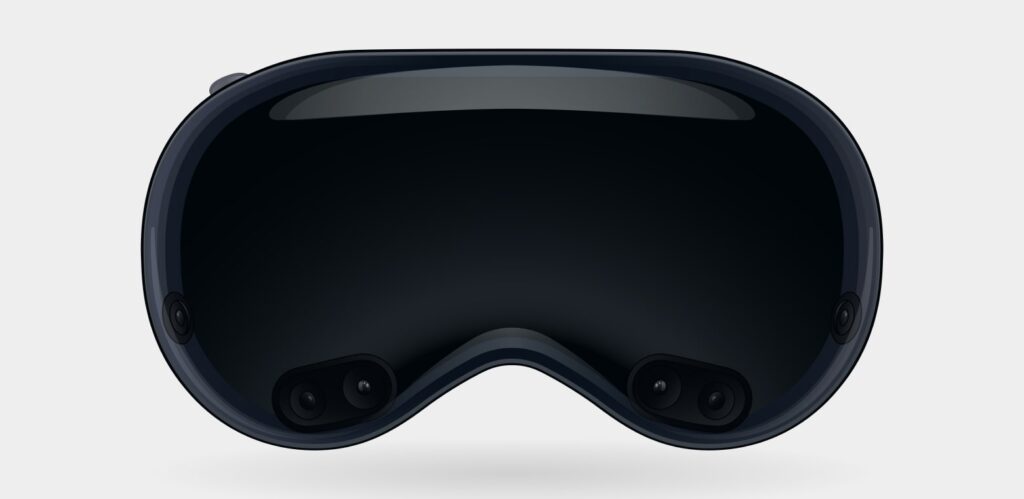
Update: Apple has officially announced that the highly anticipated Apple Vision Pro is set to be released in the U.S. on February 2, 2024.
After waiting years for an Apple virtual reality release date, we uncover what the Apple Vision Pro has to offer and what it means for VR adoption.
Has Apple created the best VR headset? On June 5th, 2023, Apple’s VR release date was announced at California’s Worldwide Developers Conference. Apple’s CEO, Tim Cook unveiled the long awaited Apple virtual reality headset called Apple Vision Pro. Cook claims that the headset is going to revolutionize spatial computing, just as Mac did with personal computing. This Apple AR/VR mixed reality headset presents a much more social approach to headsets with a ton of passthrough cameras that will create a projection of your eyes when other people are nearby.
To assess whether the Apple headset has successfully addressed lingering doubts in the VR realm, let's delve into a comprehensive overview of the Apple Vision Pro. We will explore its captivating features while also considering any potential disappointments that may arise.
Apple Vision Pro Overview
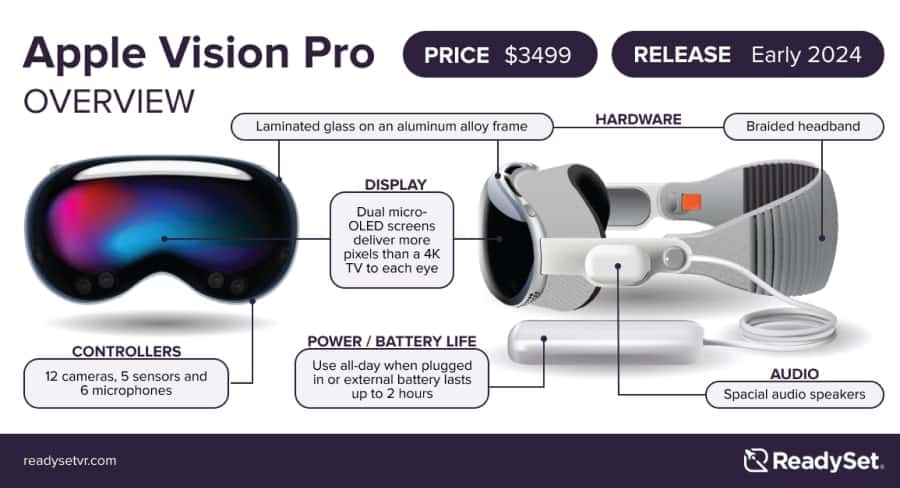
Hardware
Apple’s Vision Pro headset is designed with a focus on lightweight construction. It features a singular piece of three-dimensionally formed laminated glass on an aluminum alloy frame that curves to wrap around your face. It boasts an array of advanced hardware, including 12 cameras, 5 sensors and 6 microphones. The braided headband has an adjustment dial to accommodate all head sizes, along with an optional top head strap for additional support.
Price
This VR headset by Apple is priced at $3499, which is a higher price than the rumored $2,000-$3,000 expectation and when it is compared to its competitors such as the $999 Meta Quest Pro and $1,399 HTC Vive Pro 2.
However, it's important to note that Apple’s VR headset price aligns with their history of positioning their products as premium offerings with exceptional design and user experience. While the steep price may limit its initial market reach, Apple's brand reputation and dedicated user base could still attract a niche group of early adopters who value Apple's ecosystem and are willing to invest in the latest technology.
Release date
The Apple VR headset release date is set for early 2024. However, Apple has recently announced that the highly anticipated product will officially become available in the U.S. on apple.com, in the Apple Store app, and at Apple Stores on February 2, 2024. With pre-orders start on January 19th, 2024 at 5:00 a.m. PT.
Display
With a dual screen display, this high resolution system projects visuals that deliver more pixels than a 4K TV. It also caters to individuals who wear prescription glasses by providing vision correcting inserts, allowing them to use the device without their glasses.
The front display of the Vision Pro serves as a visual indicator for observers. It shows whether you are using the device's screen or looking beyond it. This unique feature enables you to see people around you, while also allowing them to see your eyes through the headset when they are nearby.
Apple has introduced a feature called "EyeSight" where the front screen transforms into a digital window, showing a video of your eyes within the goggles when someone approaches you. This allows you to express emotions. When engaged with immersive apps and features, the external display will exhibit different animations to indicate that you are occupied.
Audio
Spatial audio speakers positioned around the ears enhance immersion by making it seem as if the participants' voices are coming from their actual positions.
Power / battery life
The Apple Vision Pro can be used all-day when plugged in or operates wirelessly with an external battery that lasts up to 2 hours.
Controllers
One significant highlight of Apple’s AR headset is the nonexistence of handheld controllers. Instead, it relies on a user’s eyes, hands, and voice for interactions within the headset.
Apple Vision Pro Capabilities (What it can do)
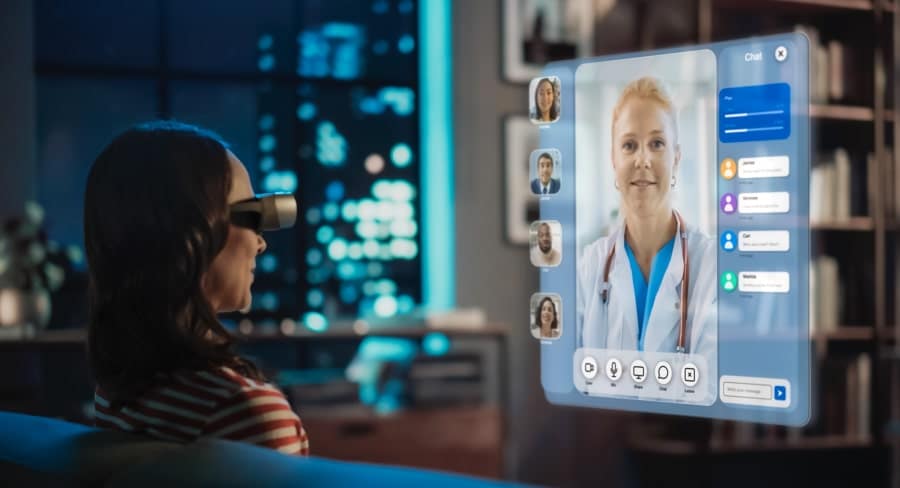
Take and view 3D pictures or video
The Vision Pro headset provides users with various features for capturing and viewing visual content. Users can view their personal pictures and videos from their camera roll, as well as take photos and record videos using the headset.
To capture 3D photos and videos, there is a dedicated button located on the top of the headset. Pressing this button allows users to capture spatial videos and/or photos that can be revisited later to 'relive the memories,' as explained by Apple.
During video recording with the headset, the external display screen flashes an animation to notify others in the vicinity that a video is being recorded.
FaceTime connection and collaboration
Using Apple Vision Pro, FaceTime becomes even better for connecting and working together. During a FaceTime call, the people you're talking to appear in large video tiles, creating a life-size representation that feels as if they are right there with you.
With the addition of Spatial Audio, their voices are precisely positioned, giving the impression that they are speaking from their actual locations. This audio technology minimizes any delay in conversations, ensuring a seamless and natural communication experience.
When wearing the Vision Pro during a FaceTime call, an Apple-developed feature called "Persona" presents a digital version of yourself in real time. It accurately captures your facial expressions and hand movements, adding another layer of immersion to your interactions. Together, you can engage in various activities such as watching movies, viewing photos, or collaborating on a presentation.
Use desktop/mobile applications with AR
The Vision Pro headset integrates augmented reality, enabling the projection of virtual elements onto the real world. While wearing the Vision Pro headset, the apps you view will appear suspended in the air in front of you, seamlessly integrating with the physical room you are in. However, certain apps and functionalities can obstruct your field of vision with digital effects. For instance, there is a movie theater mode that generates a digital screen along with a virtual backdrop behind it.
The Vision Pro currently supports Apple Arcade games and apps that were originally designed for iPhones and iPads. Additionally, the headset is compatible with desktop applications like Adobe Lightroom and Microsoft Office, allowing users to leverage its capabilities while working with these familiar software tools.
Apple Vision Pro Limitations (What it can’t do)
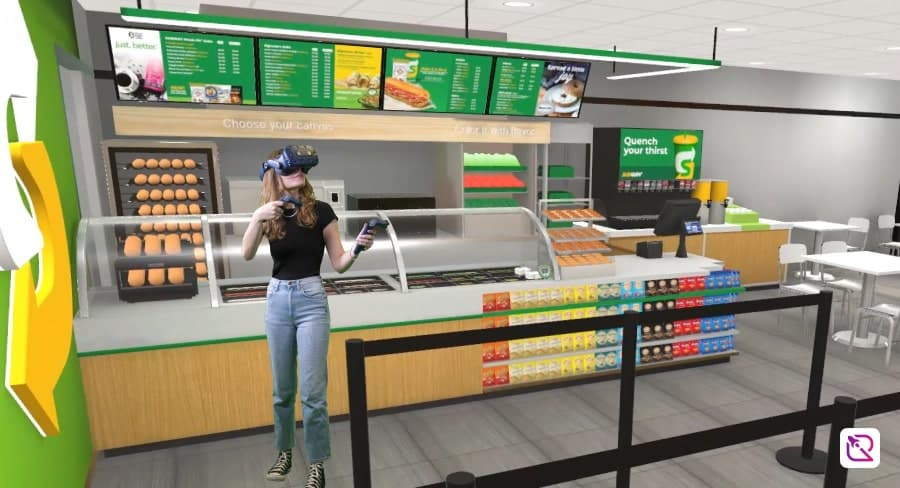
Does not support Immersive VR experiences
When watching movies in the Vision Pro, the dial gives you the option to wrap the 3D screen around you, providing an immersive experience within the confines of a 2D environment. However, it's important to clarify that the device does not support fully immersive VR experiences, where users can fully engage with a 3D virtual environment and experience a heightened sense of presence and interaction with their surroundings.
While the Vision Pro excels in delivering a high-quality visual and audio experience, it is primarily designed for augmented reality (AR) and mixed reality (MR) applications. Its focus is on blending virtual and real-world elements, creating an interactive and immersive experience that augments the user's perception of reality. While it offers an enhanced viewing experience, it does not provide the level of complete immersion typically associated with dedicated VR devices.
Incompatible with current VR games and applications
One major disadvantage of the Vision Pro VR headset is its inability to run the majority of VR games or applications. The Vision Pro exclusively runs on Apple's operating system platform called VisionOS, resulting in a unique library of applications available solely on Apple's platform. In contrast, most virtual reality games utilize the Steam platform to power and run their applications, which offers compatibility with a wide range of VR headsets from various manufacturers, such as Valve, Meta, HTC, HP, and Windows.
In addition to the differences in software, the interactive tools of the Vision Pro also set it apart. Unlike the controllers commonly used in VR gaming, the Apple headset lacks VR controllers, posing a significant drawback for gamers. Instead, users must rely solely on hand gestures, eye movements, and voice commands to interact with and control applications on the headset, resulting in a completely different control scheme compared to the standard VR gaming experience.
As a result, the selection of available apps for gaming and other purposes on the Vision Pro VR headset is currently limited. However, Apple has taken steps to address this issue by creating a developer kit set to be released later this year. Starting in July, developer kits will be made available, inviting developers to create content specifically for the VisionOS platform. This includes developers who have been utilizing Unity's authoring tools to construct 3D applications and games, allowing them to transfer their Unity apps to the Apple Vision Pro.
While the pricing details for the developer kit are yet to be disclosed, participants in the program will benefit from direct Apple support and testing opportunities. Furthermore, developer labs will be established in various locations worldwide, including Cupertino, London, Munich, Shanghai, Singapore, and Tokyo. These labs will provide developers with the ability to test their apps and receive hands-on support from Apple engineers.
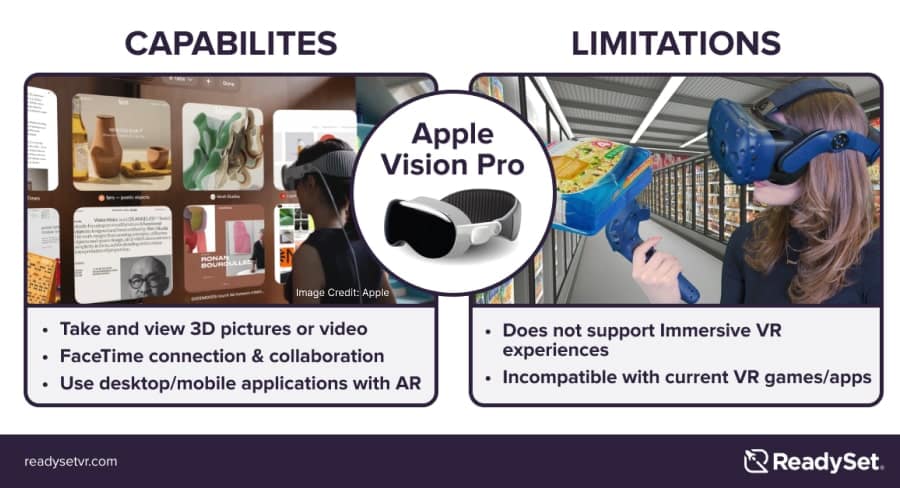
What does this mean for the future of VR?
ReadySet's expert opinion
ReadySet VR's COO, Will Van Epern, shares his perspective on Apple's VR headset: "Initially, I was somewhat disappointed that Apple's new headset focused on AR rather than immersive VR. However, as Apple positions it as a mixed reality headset, there is potential for them to prioritize VR in the future. Apple's emphasis on spatial computing brings to mind previous endeavors like Google Glasses and Microsoft HoloLens. Nevertheless, Apple's unique approach and allowance of Meta to own the metaverse, gives hope for their future success." When asked about his plans to purchase the Vision Pro once Apple announces a VR release date, he responded, "While I don't intend to invest in this first edition of the Apple XR headset, I remain optimistic about its future, considering its support of Unity and XML. Currently, the Apple Vision Pro Mixed Reality Headset resembles an expensive desktop that requires substantial content development to deliver experiences not available on a Mac or iPad."
Regarding whether this new technology will assist in VR adoption, a significant barrier for the industry, he expressed, "Ultimately, it will contribute to the long-term adoption of VR. However, in the short term, the high price point is likely to attract only a niche group of early adopters within Apple's user base."
Industry Impact
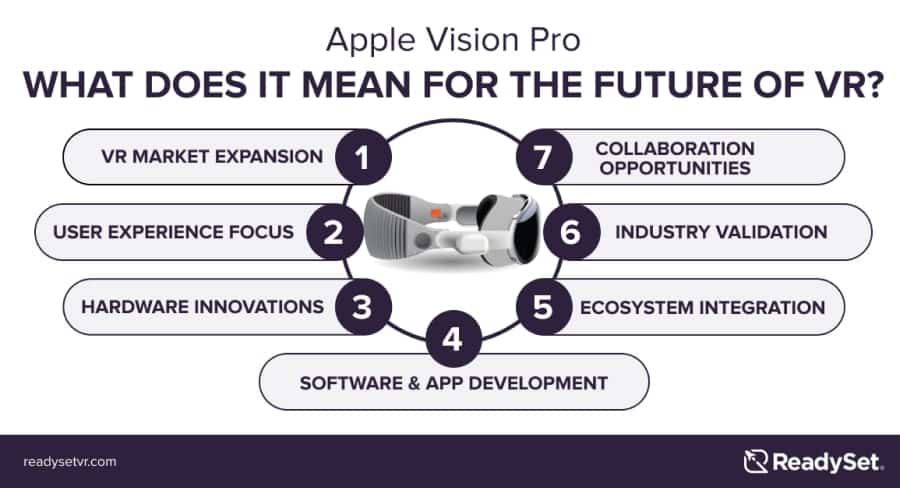
-
-
VR market expansion
Apple's entry into the VR market could bring a significant boost in mainstream adoption and awareness of VR technology. This could lead to a larger market size and increased demand for VR software and experiences.
-
User Experience Focus
Apple is renowned for its emphasis on user experience and design. With the introduction of the Vision Pro headset, Apple has taken user features to a new level, enabling enhanced augmented reality and immersive experiences. Notably, the front-facing display and external animations highlight Apple's commitment to improving user awareness and interaction within both virtual and physical worlds.
These advancements hold the potential to create more immersive and context-aware VR experiences, effectively bridging the gap between digital and real environments. By integrating human controls such as hands, eyes, and voice, Apple pushes the boundaries beyond traditional displays. The seamless blending of virtual elements with the real world in the Vision Pro offers a unique and interactive way to engage with digital content.
By leveraging their expertise in creating intuitive and user-friendly interfaces, Apple's focus on user experience can make VR more accessible and appealing to a broader audience. This emphasis on user-centric design has the potential to attract newcomers to VR and increase overall engagement with VR software.
-
Hardware Innovations
Apple's investment in research and development, coupled with their expertise in hardware design, has the potential to drive significant advancements in VR hardware. An impressive innovation is the utilization of eye-tracking technology for the "EyeSight" feature, which allows the user's eyes to be visible on the outward display. This visibility enables those nearby to know that the user can see them, addressing a key challenge of other VR devices. This breakthrough opens up possibilities for improved communication and social interactions within virtual spaces. Consequently, this innovation could lead to a greater emphasis on these aspects within the broader VR hardware market.
Additionally, Apple's dedication to hardware innovation may result in improvements in display quality, comfort, weight, and ergonomics. These enhancements contribute to an overall enhanced VR experience, making it more enjoyable for users.
-
Software and App Development
Apple's strong developer ecosystem and app store could encourage the creation of a wide range of VR software, games, and experiences. This could lead to a larger and more diverse content library, offering users a variety of compelling options. For VR software companies, this presents an opportunity to leverage Apple's platform and reach a larger user base.
-
Ecosystem Integration
Apple's integration of hardware, software, and services across their ecosystem could create seamless experiences between different devices. This could enable users to transition between their Apple devices and the VR headset more smoothly, opening up possibilities for cross-platform interactions and content sharing.
-
Industry Validation
Apple's entry into the VR market brings a level of credibility and validation to the industry. Their brand recognition and reputation for quality could instill confidence in consumers and investors, further fueling the growth and development of the VR industry.
-
Collaboration Opportunities
Apple's technology could potentially open up collaboration opportunities for VR software companies. By leveraging Apple's ecosystem and tools, developers may be able to create integrated and innovative solutions that enhance the overall VR experience.
-
Overall, Apple's Vision Pro represents a significant step forward in the evolution of VR, pushing the boundaries of technology and user experience. Its innovative features and focus on merging AR and VR technology capabilities hold promise for shaping the future of how we interact, communicate, and engage with virtual environments.
Subscribe to our newsletter
Get our blogs and the latest retail news delivered to your inbox monthly.
Recent Posts
Tech To Watch From Chicago’s 2024 Retail Innovation Conference
The Retail Innovation Conference & Expo 2024 explored AI, brand activations, immersive experiences and how culture can offer a better way to understand consumers than demographics. The 2024 Retail Innovation Conference in Chicago was a hub of groundbreaking ideas and emerging technologies, setting the stage for the future of retail. This year’s conference highlighted the…
3D and VR Software Enhancing Retail Assortment Planning
As inflation challenges persist, brands and retailers are leveraging virtual reality technology for cost-effective merchandise assortment planning that helps reduce planning overhead and improve store level compliance that drives conversion. In the ever-evolving retail landscape, staying ahead of trends in product categories and consumer behaviors is critical for success. As we navigate through 2024, retailers…
How VR is Revolutionizing Packaging Design and Research
Virtual reality offers an innovative packaging design solution for the food and CPG industry. Virtual Reality (VR) is changing packaging design and research by offering unique capabilities to innovate, iterate, and optimize. Traditionally, packaging design involved labor-intensive processes such as creating physical mock-ups and conducting extensive testing. This consumes time and materials. Designers may need…




[…] talking about mixed reality solutions, we can’t help but mention Apple’s Vision Pro. An Apple XR headset has been long-awaited and is anticipated to be a revolutionary device akin to […]